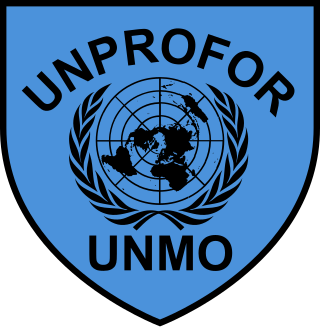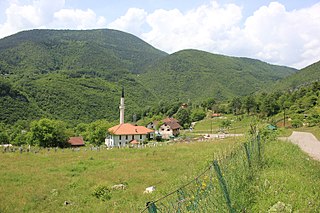
The siege of Sarajevo was a prolonged blockade of Sarajevo, the capital of Bosnia and Herzegovina, during the ethnically charged Bosnian War. After it was initially besieged by Serbian forces of the Yugoslav People's Army, the city was then besieged by the Army of Republika Srpska. Lasting from 5 April 1992 to 29 February 1996, it was three times longer than the Battle of Stalingrad, more than a year longer than the siege of Leningrad, and was the longest siege of a capital city in the history of modern warfare.

The Bosnian War was an international armed conflict that took place in Bosnia and Herzegovina between 1992 and 1995. The war is commonly seen as having started on 6 April 1992, following several earlier violent incidents. It ended on 14 December 1995 when the Dayton Accords were signed. The main belligerents were the forces of the Republic of Bosnia and Herzegovina, the Republic of Herzeg-Bosnia, and the Republika Srpska, the latter two entities being proto-states led and supplied by Croatia and Serbia, respectively.

The Srebrenica massacre, also known as the Srebrenica genocide, was the July 1995 genocidal killing of more than 8,000 Bosniak Muslim men and boys in and around the town of Srebrenica during the Bosnian War. It was mainly perpetrated by units of the Bosnian Serb Army of Republika Srpska under Ratko Mladić, though the Serb paramilitary unit Scorpions also participated. The massacre was the first legally recognised genocide in Europe since the end of World War II.

The United Nations Protection Force was the first United Nations peacekeeping force in Croatia and in Bosnia and Herzegovina during the Yugoslav Wars. The force was formed in February 1992 and its mandate ended in March 1995, with the peacekeeping mission restructuring into three other forces.

Sanski Most is a town and municipality located in the Una-Sana Canton of the Federation of Bosnia and Herzegovina, an entity of Bosnia and Herzegovina. It is situated on the banks of the Sana River in northwestern Bosnia and Herzegovina, in the region of Bosanska Krajina, between Prijedor and Ključ. As of 2013, it has a population of 41,475 inhabitants.

Operation Deliberate Force was a sustained air campaign conducted by NATO, in concert with the UNPROFOR ground operations, to undermine the military capability of the Army of Republika Srpska, which had threatened and attacked UN-designated "safe areas" in Bosnia and Herzegovina during the Bosnian War with the Srebrenica genocide and Markale massacres, precipitating the intervention. The shelling of the Sarajevo marketplace on 28 August 1995 by the VRS is considered to be the immediate instigating factor behind NATO's decision to launch the operation.

A Sarajevo Rose is a type of memorial in Sarajevo made from concrete scar caused by a mortar shell's explosion that was later filled with red resin. Mortar rounds landing on concrete during the siege of Sarajevo created a unique fragmentation pattern that looks almost floral in arrangement, and therefore have been named "rose".

The Markale market shelling or Markale massacres were two separate bombardments, with at least one of them confirmed to have been carried out by the Army of Republika Srpska, targeting civilians during the siege of Sarajevo in the Bosnian War. They occurred at the Markale (marketplace) located in the historic core of Sarajevo, the capital of Bosnia and Herzegovina.
Operation Sana was the final military offensive of the Army of the Republic of Bosnia and Herzegovina in western Bosnia and Herzegovina and the last major battle of the Bosnian War. It was launched from the area of Bihać on 13 September 1995, against the Army of Republika Srpska, and involved advances towards Bosanski Petrovac, Sanski Most and Bosanska Krupa. At the same time, the Croatian Army and the Croatian Defence Council were engaging the VRS in Operation Maestral 2 further to the southeast. After an initial 70-kilometre (43 mi) advance, VRS reinforcements managed to stop the ARBiH short of Sanski Most and Bosanski Novi, and reversed some of the ARBiH's territorial gains in a counterattack. After a part of the ARBiH 5th Corps was threatened with defeat around the town of Ključ, the ARBiH requested assistance from the HV.

During the Bosnian War, there was an ethnic cleansing campaign committed by the Bosnian Serb political and military leadership – Army of the Republika Srpska, mostly against Bosniak and Croat civilians in the Prijedor region of Bosnia and Herzegovina in 1992 and 1993. The composition of non-Serbs was drastically reduced: out of a population of 50,000 Bosniaks and 6,000 Croats, only some 6,000 Bosniaks and 3,000 Croats remained in the municipality by the end of the war. Apart from the Srebrenica massacre, Prijedor is the area with the second highest rate of civilian killings committed during the Bosnian War. According to the Sarajevo-based Research and Documentation Center (IDC), 4,868 people were killed or went missing in the Prijedor municipality during the war. Among them were 3,515 Bosniak civilians, 186 Croat civilians and 78 Serb civilians. As of October 2013, 96 mass graves have been located and around 2,100 victims have been identified, largely by DNA analysis.

United Nations Security Council resolution 819, adopted unanimously on 16 April 1993, after reaffirming resolutions 713 (1991) and all (1992) subsequent resolutions, the Council expressed concern at the actions of Bosnian Serb paramilitary units in towns and villages in eastern Bosnia and Herzegovina, including attacks on civilians, the United Nations Protection Force and disruption to humanitarian aid convoys. The resolution marked the UN's first civilian "safe area" being declared; it failed to prevent the Srebrenica massacre.

The siege of Srebrenica was a three-year siege of the town of Srebrenica in eastern Bosnia and Herzegovina which lasted from April 1992 to July 1995 during the Bosnian War. Initially assaulted by the Yugoslav People's Army (JNA) and the Serbian Volunteer Guard (SDG), the town was encircled by the Army of Republika Srpska (VRS) in May 1992, starting a brutal siege which was to last for the majority of the Bosnian War. In June 1995, the commander of the Army of the Republic of Bosnia and Herzegovina (ARBiH) in the enclave, Naser Orić, left Srebrenica and fled to the town of Tuzla. He was subsequently replaced by his deputy, Major Ramiz Bećirović.

Ratko Mladić is a Bosnian Serb former military officer and convicted war criminal who led the Army of Republika Srpska (VRS) during the Yugoslav Wars. In 2017, he was found guilty of committing war crimes, crimes against humanity, and genocide by the International Criminal Tribunal for the former Yugoslavia (ICTY). He is serving a life sentence for these crimes in The Hague.
The Dobrinja mortar attack was a massacre which occurred at 10:20 a.m. on 1 June 1993, in Dobrinja, a suburb west of Sarajevo in Bosnia and Herzegovina. Two mortar rounds were fired from Serb-held positions, hitting a football pitch where youths put on an impromptu game on the first day of the Muslim holiday Kurban Bajram. Approximately 200 people were in attendance to watch the game. The United Nations placed the official death toll stemming from the mortar attack at 13, with 133 wounded. At the time it was the deadliest event involving civilians since the imposition of sanctions against the Federal Republic of Yugoslavia by the United Nations one year prior.
The Prosecutor v. Ratko Mladić was a war crimes trial before the International Criminal Tribunal for the former Yugoslavia (ICTY) in The Hague, Netherlands, concerning crimes committed during the Bosnian War by Ratko Mladić in his role as a general in the Yugoslav People's Army and the Chief of Staff of the Army of Republika Srpska.

Sarajevo, the capital of Bosnia and Herzegovina has gained international notoriety for its diverse range of street art and associated subcultures. The city has a long history of street art that was first tied to various subcultures in the 1970s and 1980s. During the Bosnian war political and anti-war street art was one of the main artistic focal points of the besieged city. Today, Sarajevo is a European center for street art and hosts two international festivals dedicated to the art form.
The Zenica massacre happened on 19 April 1993, shortly after noon. Several shells fired from the Croatian Defence Council’s positions located in Putićevo village, about 16 km (9.9 mi) west of Zenica, killed 16 and injured over 50 civilians in a large crowd.

Trg oslobođenja - Alija Izetbegović is a square in Sarajevo, Bosnia and Herzegovina. It lies between the municipalities Stari Grad and Centar. It links the main pedestrian thoroughfare of the Sarajevo old town, Ferhadija street, with Zelenih Beretki street, with the Dom Armije (1881). On its east side it hosts the Orthodox Cathedral (1874) and the University of Sarajevo School of Economics and Business. On its west is the Svjetlost building, while at its south, beyond Zelenih Beretki, stands the Dom Armije (1881)

The siege of Žepa was a three-year long siege of the small Bosnian town of Žepa which had lasted from the summer of 1992 – July 1995 during the Bosnian War. It was initially besieged by the Yugoslav People's Army (JNA) until it switched to the VRS. Throughout the siege, Žepa was part of the Srebrenica–Žepa link in eastern Bosnia. From April 1992 – February 1993, the ARBiH and the civilians of Žepa successfully resisted the Bosnian Serb army due to applying to guerrilla warfare.
















